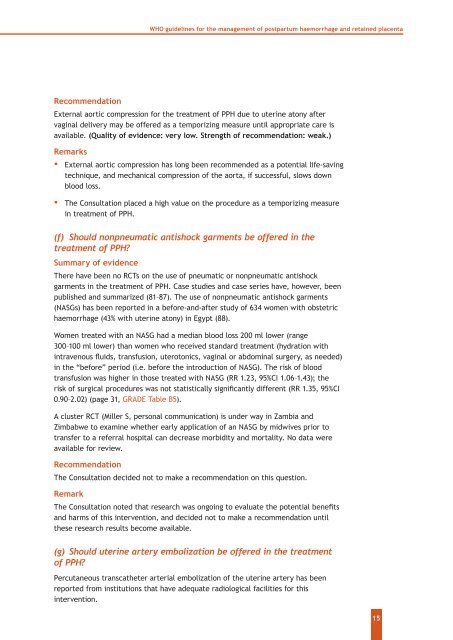WHO guidelines for the management of postpartum haemorrhage ...
WHO guidelines for the management of postpartum haemorrhage ...
WHO guidelines for the management of postpartum haemorrhage ...
Create successful ePaper yourself
Turn your PDF publications into a flip-book with our unique Google optimized e-Paper software.
<strong>WHO</strong> <strong>guidelines</strong> <strong>for</strong> <strong>the</strong> <strong>management</strong> <strong>of</strong> <strong>postpartum</strong> <strong>haemorrhage</strong> and retained placenta<br />
Recommendation<br />
External aortic compression <strong>for</strong> <strong>the</strong> treatment <strong>of</strong> PPH due to uterine atony after<br />
vaginal delivery may be <strong>of</strong>fered as a temporizing measure until appropriate care is<br />
available. (Quality <strong>of</strong> evidence: very low. Strength <strong>of</strong> recommendation: weak.)<br />
Remarks<br />
▪ External aortic compression has long been recommended as a potential life-saving<br />
technique, and mechanical compression <strong>of</strong> <strong>the</strong> aorta, if successful, slows down<br />
blood loss.<br />
▪ The Consultation placed a high value on <strong>the</strong> procedure as a temporizing measure<br />
in treatment <strong>of</strong> PPH.<br />
(f) Should nonpneumatic antishock garments be <strong>of</strong>fered in <strong>the</strong><br />
treatment <strong>of</strong> PPH?<br />
Summary <strong>of</strong> evidence<br />
There have been no RCTs on <strong>the</strong> use <strong>of</strong> pneumatic or nonpneumatic antishock<br />
garments in <strong>the</strong> treatment <strong>of</strong> PPH. Case studies and case series have, however, been<br />
published and summarized (81–87). The use <strong>of</strong> nonpneumatic antishock garments<br />
(NASGs) has been reported in a be<strong>for</strong>e-and-after study <strong>of</strong> 634 women with obstetric<br />
<strong>haemorrhage</strong> (43% with uterine atony) in Egypt (88).<br />
Women treated with an NASG had a median blood loss 200 ml lower (range<br />
300–100 ml lower) than women who received standard treatment (hydration with<br />
intravenous fluids, transfusion, uterotonics, vaginal or abdominal surgery, as needed)<br />
in <strong>the</strong> “be<strong>for</strong>e” period (i.e. be<strong>for</strong>e <strong>the</strong> introduction <strong>of</strong> NASG). The risk <strong>of</strong> blood<br />
transfusion was higher in those treated with NASG (RR 1.23, 95%CI 1.06–1.43); <strong>the</strong><br />
risk <strong>of</strong> surgical procedures was not statistically significantly different (RR 1.35, 95%CI<br />
0.90–2.02) (page 31, GRADE Table B5).<br />
A cluster RCT (Miller S, personal communication) is under way in Zambia and<br />
Zimbabwe to examine whe<strong>the</strong>r early application <strong>of</strong> an NASG by midwives prior to<br />
transfer to a referral hospital can decrease morbidity and mortality. No data were<br />
available <strong>for</strong> review.<br />
Recommendation<br />
The Consultation decided not to make a recommendation on this question.<br />
Remark<br />
The Consultation noted that research was ongoing to evaluate <strong>the</strong> potential benefits<br />
and harms <strong>of</strong> this intervention, and decided not to make a recommendation until<br />
<strong>the</strong>se research results become available.<br />
(g) Should uterine artery embolization be <strong>of</strong>fered in <strong>the</strong> treatment<br />
<strong>of</strong> PPH?<br />
Percutaneous transca<strong>the</strong>ter arterial embolization <strong>of</strong> <strong>the</strong> uterine artery has been<br />
reported from institutions that have adequate radiological facilities <strong>for</strong> this<br />
intervention.<br />
15
















